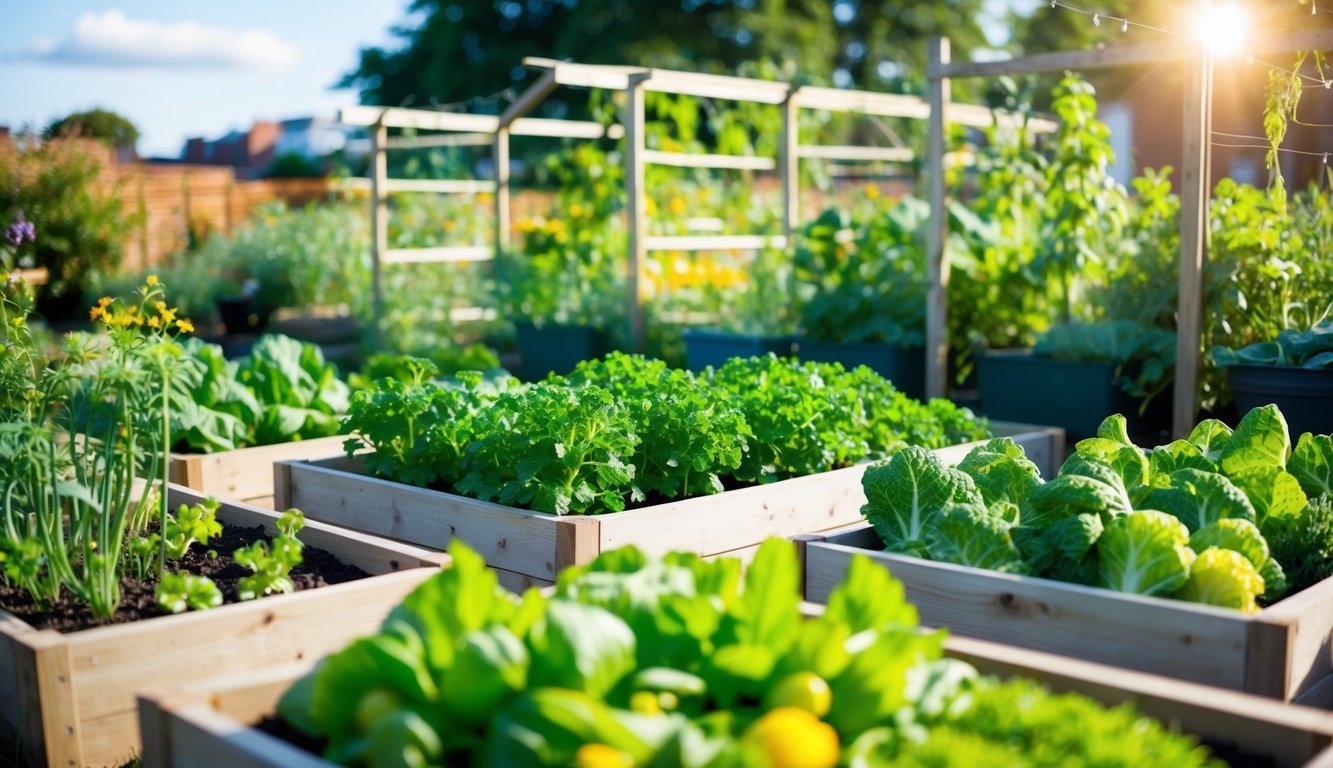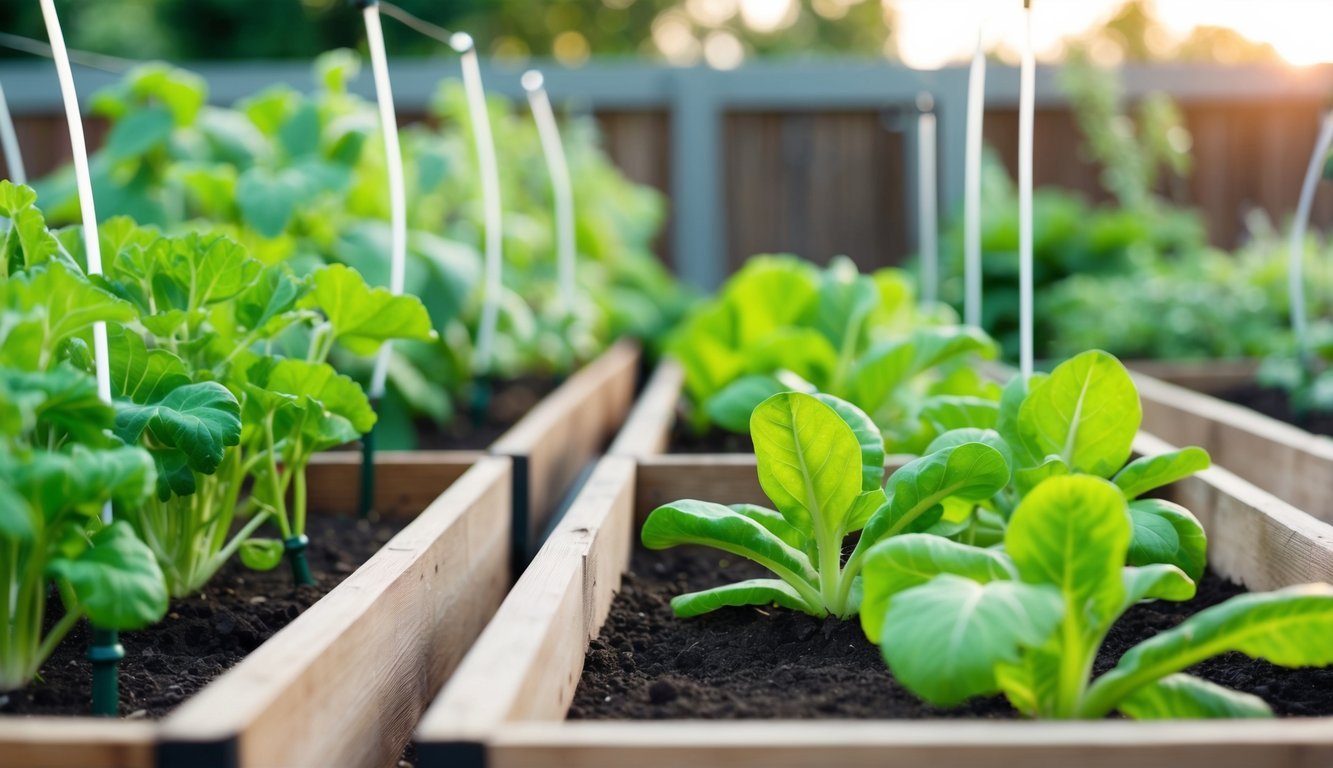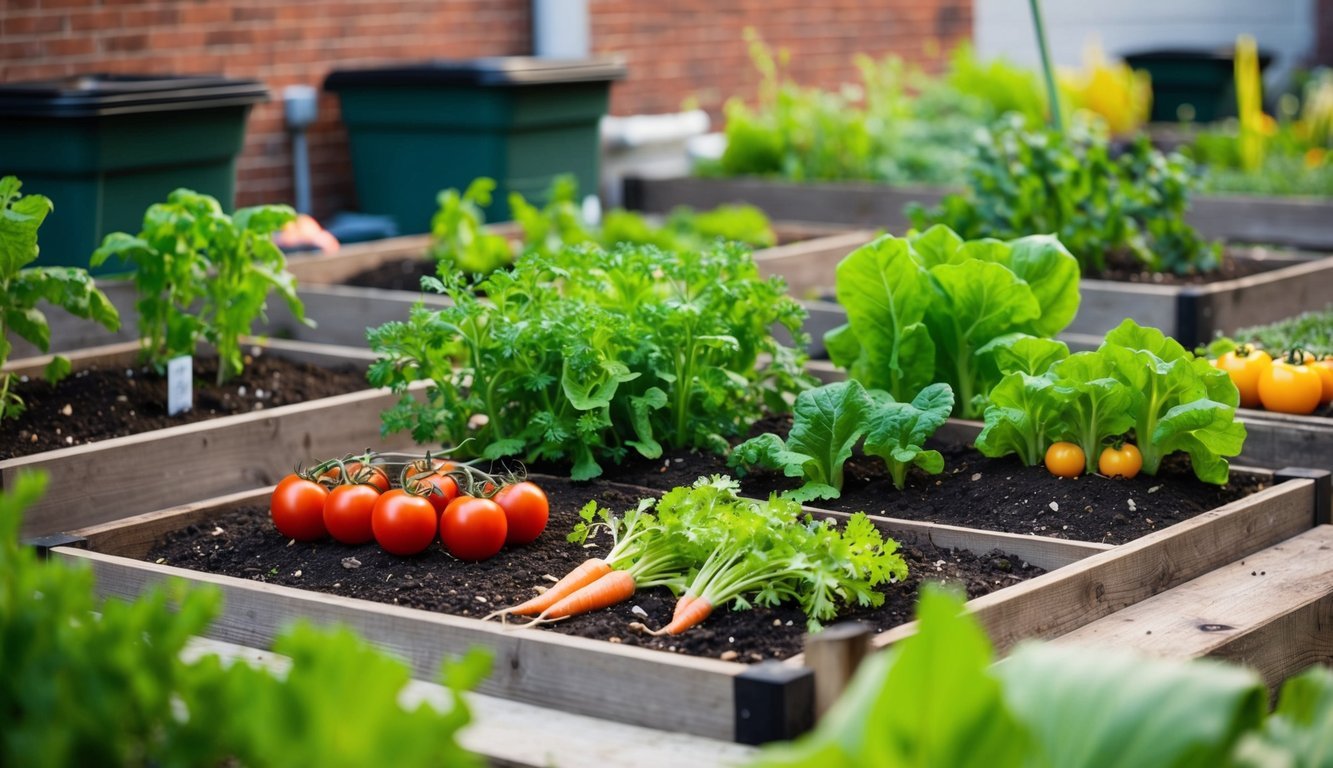Growing organic vegetables in a small space can be quite the adventure.
I’ve discovered that even the tiniest balcony or backyard corner can become a vibrant patch of fresh produce. With the right techniques, anyone can cultivate a flourishing garden, regardless of size.

Whether you’re a seasoned gardener or just starting, maximizing your space is key.
I’ve learned several practices that not only enhance the yield but also simplify the process.
Getting creative with what I have has turned small gardening into a fun, rewarding experience.
Companion planting with herbs like basil
When I think about maximizing my small garden space, companion planting always comes to mind.
Basil is a fantastic choice for pairing with other vegetables.
Its strong aroma not only enhances flavors but also repels pests.
I often plant basil alongside tomatoes.
They thrive together, leading to healthier plants and better yields.
The basil helps fend off pests like spider mites and flies that can target tomatoes.
Another great companion is peppers.
Basil supports them by repelling certain insects and even boosting their flavor.
It’s a win-win for me in the garden.
I’ve also found that chives can be good buddies for basil.
They don’t compete for space too much, and their flavors complement each other well in cooking.
Just a heads up, some plants don’t get along with basil.
For instance, cucumbers and fennel can compete for resources and may not thrive when planted nearby.
It’s important to consider these relationships when planning my garden layout.
2) Vertical gardening with trellises
Vertical gardening has completely transformed my small space gardening experience.
Utilizing trellises allows me to grow plants upward, which is a game changer when I’m short on horizontal space.
I’ve found that vining vegetables like cucumbers and peas thrive when given the chance to climb.
The trellis not only supports the plants but also makes harvesting much easier.
Plus, it keeps the vegetables off the ground, which helps reduce pests and disease.
Setting up a trellis is simple.
I usually use materials like wood, wire, or even repurposed items.
The key is to ensure it’s sturdy enough to hold the weight of the plants.
By growing vertically, I can fit more plants in my garden.
It’s surprising how many vegetables I can grow in a small area when they’re trained to climb.
This method definitely boosts my yield while keeping my garden looking neat and organized.
3) Using grow bags for mobility
I love using grow bags because they offer incredible mobility in my gardening setup.
Unlike traditional garden beds, I can easily move the bags around to find the best spots for sunlight and airflow.
When I notice certain plants aren’t thriving, I simply shift the bags to a more suitable location.
This flexibility ensures that my vegetables get the right conditions to grow.
Another great advantage is being able to follow the sun.
As seasons change, I can reposition my grow bags to make the most of the available light.
Plus, if I’m working on my patio or balcony, I can easily rearrange the bags to optimize space.
This way, I can enjoy my garden without sacrificing my limited area.
Using grow bags makes experimenting with different plant placements simple and fun.
It’s all about finding what works best for each vegetable.
4) Mulching with straw for soil health
Mulching with straw has been a game changer in my small vegetable garden.
I apply it in a thick layer, typically around four to six inches deep.
This depth ensures good coverage and prevents weeds from taking over.
As the straw breaks down, it adds valuable nutrients back into the soil.
I love how it improves soil fertility over time, making my plants healthier.
Plus, it helps retain moisture, especially during dry spells.
Another benefit I appreciate is the insulation it provides.
Straw creates a protective layer that fosters beneficial microbes, enhancing soil health and structure.
I find that my plants thrive better with this natural approach.
Straw is also easy to work with.
I just spread it out between my rows and enjoy a more manageable garden.
Using straw as a mulch makes my gardening experience smoother and more productive.
5) Drip irrigation systems for efficiency

I’ve found that drip irrigation systems are a game changer for growing organic vegetables in small spaces.
They allow me to deliver water directly to the plants’ roots, which reduces waste.
This focused approach not only conserves water but also promotes healthier plant growth.
Setting up a drip system has become one of my favorite gardening practices.
With the right components, like tubing and emitters, I can customize it to fit my garden layout.
This flexibility means I can adjust the system for different plant types and varying soil conditions.
Using drip irrigation has also reduced weed issues in my garden.
Since the water goes straight to the roots, there’s less moisture on the surface, which discourages weed growth.
This helps me spend less time weeding and more time enjoying my garden.
Maintaining my drip system is straightforward too.
Regular checks ensure everything is functioning properly, allowing me to focus on plant care rather than worrying about watering schedules.
For anyone looking to grow vegetables efficiently, I highly recommend considering this method.
Raised beds for better soil drainage

Using raised beds has been a game changer for me when it comes to managing soil drainage.
The elevation enhances drainage, helping prevent water from pooling around the roots of my plants.
I’ve noticed that the soil warms up faster in the spring, which is great for getting an early start on my vegetables.
This means I can enjoy a longer growing season.
In my raised beds, I mix high-quality topsoil with compost and organic matter.
This combination not only improves soil structure but also aids drainage.
To enhance drainage further, I sometimes add perlite or vermiculite.
These materials help create air pockets that encourage healthy root development.
Choosing the right location for my raised beds is also crucial.
I make sure to pick a sunny spot that drains well, as most of my vegetables thrive with good sunlight and moisture balance.
7) Succession planting for continuous harvest

Succession planting is one of my favorite ways to keep my garden thriving all season long.
It involves planting the same crop at intervals, so I can enjoy fresh produce over an extended period.
I love starting with fast-growing plants like radishes or lettuce.
I’ll sow a new batch every couple of weeks.
This means I can always grab a fresh salad mix without overwhelming my kitchen with too much at once.
For longer-growing crops, I stagger plantings too.
For instance, I plant my tomatoes in phases.
This way, I get a steady supply throughout the summer, rather than a single big harvest.
Timing is key.
I often refer to a planting calendar to track when to sow seeds based on my local frost dates.
It makes planning simpler and more effective.
Consider your space wisely.
Even in a small garden, I can maximize my yields by rotating crops and using vertical gardening techniques.
Understanding Your Space

Before I jump into planting, I always take a good look at my space.
Knowing where the sunlight hits and how I can use vertical space can make a huge difference in my small vegetable garden.
Let’s break it down.
Evaluating Sunlight Availability
Sunlight is crucial for growing healthy organic vegetables.
I’ve found that most veggies need at least six hours of direct sunlight each day.
To evaluate sunlight availability, I take note of the sun’s movement throughout the day.
I often use a simple sun chart or even an app to track how shadows move across my space.
This helps me find the sunniest spots on my balcony, patio, or windowsill.
If you notice some areas only get partial sunlight, consider planting shade-tolerant crops like spinach or lettuce there.
Keeping a journal of sunlight patterns is also a great way to refine my planting strategy each season.
Maximizing Vertical Space
When space is tight, I love taking advantage of vertical gardening.
Utilizing walls, fences, or even hanging planters can really expand my options.
For instance, installing shelves or vertical planters allows me to grow more without taking up extra ground space.
I’ve found that climbing plants like cucumbers and peas are perfect for vertical growth, especially when I add a trellis.
Another handy tip is to use stackable pots.
They save room and provide a fun visual appeal.
Don’t forget to keep a set of small hooks or nails handy for hanging pots or even wall-mounted planter boxes.
Soil and Nutrient Management

Managing soil and nutrients effectively is crucial when growing organic vegetables, especially in small spaces.
A healthy soil creates a thriving environment for plants, while proper nutrient management supports robust growth and high yields.
Here are some vital practices to enhance your soil quality and maximize fertility.
Improving Soil Quality
To grow organic vegetables, I focus on building high-quality soil.
Starting with good soil structure is key.
I ensure my soil retains enough moisture and drains well by mixing in adequate organic matter.
Adding amendments like compost, leaf mold, or well-rotted manure can significantly boost soil health.
Soil testing is a must too.
It helps me understand nutrient levels and pH, so I can adjust accordingly.
Keeping the soil alive with beneficial microbes promotes nutrient availability.
I also consider cover crops to prevent erosion and add nutrients back into the soil.
Cover crops like clover and vetch work wonders for building organic matter and fixing nitrogen.
Composting Basics
Composting has been invaluable in my organic gardening journey.
It recycles kitchen scraps and yard waste while providing nutrient-rich additions to my soil.
I start by gathering materials, separating them into green (nitrogen-rich) and brown (carbon-rich) components.
A good ratio is about 3 parts brown to 1 part green.
I layer these materials in a bin or pile, making sure to turn the compost regularly.
This aeration speeds up decomposition, typically producing compost in 3 to 6 months.
The finished product should be dark, crumbly, and earthy-smelling.
Mixing this compost into my garden beds keeps my plants healthy and improves soil structure.

